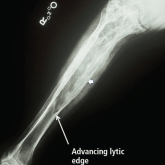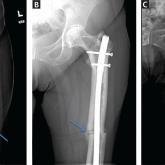User login
Improving Oral Chemotherapy Documentation Using QOPI Audit, Plan-Do-Study-Act Cycles, and the Electronic Medical Record
Background: The use of oral chemotherapy in cancer patients continues to increase and proper documentation of patient adherence, duration of treatment and side effects while on these medications is important. The Quality Oncology Practice Initiative (QOPI) identified oral chemotherapy documentation as an area in need of improvement.
Methods: We used the QOPI audit to create a quality improvement project with the goal of improving our provider oral chemotherapy documentation including cycle number, adherence and side effects. An existing oral chemotherapy best practice alert template in our electronic medical record had already been created to help our providers document oral chemotherapy administration, and we sought to improve our documentation by increasing our provider compliance in completing this template. We utilized Plan-Do-Study- Act (PDSA) cycles to accomplish our goal. For the first PDSA cycle, we made bypassing the oral chemotherapy documentation template in our electronic medical record more difficult for our providers. Our providers were required to acknowledge the template by either following the link to complete the template or documenting a reason why the template was not completed. Requiring the provider to document a reason why the template was not completed made bypassing the template more difficult.
Results: By making this change to the template, we successfully improved our provider compliance with following the link to complete the template from 38% (83/220) to 71% (121/169). For the second PDSA cycle, we educated our medical oncology providers via email about the importance of utilizing the template to improve our oral chemotherapy documentation. By educating our providers, we improved our provider compliance with following the link to complete the template to 86.5% (155/179).
Conclusion: Our project showed how the QOPI audit can be used to create a quality improvement project. Our project also demonstrated how templates within the electronic medical record can be utilized to complete a successful quality improvement project.
Background: The use of oral chemotherapy in cancer patients continues to increase and proper documentation of patient adherence, duration of treatment and side effects while on these medications is important. The Quality Oncology Practice Initiative (QOPI) identified oral chemotherapy documentation as an area in need of improvement.
Methods: We used the QOPI audit to create a quality improvement project with the goal of improving our provider oral chemotherapy documentation including cycle number, adherence and side effects. An existing oral chemotherapy best practice alert template in our electronic medical record had already been created to help our providers document oral chemotherapy administration, and we sought to improve our documentation by increasing our provider compliance in completing this template. We utilized Plan-Do-Study- Act (PDSA) cycles to accomplish our goal. For the first PDSA cycle, we made bypassing the oral chemotherapy documentation template in our electronic medical record more difficult for our providers. Our providers were required to acknowledge the template by either following the link to complete the template or documenting a reason why the template was not completed. Requiring the provider to document a reason why the template was not completed made bypassing the template more difficult.
Results: By making this change to the template, we successfully improved our provider compliance with following the link to complete the template from 38% (83/220) to 71% (121/169). For the second PDSA cycle, we educated our medical oncology providers via email about the importance of utilizing the template to improve our oral chemotherapy documentation. By educating our providers, we improved our provider compliance with following the link to complete the template to 86.5% (155/179).
Conclusion: Our project showed how the QOPI audit can be used to create a quality improvement project. Our project also demonstrated how templates within the electronic medical record can be utilized to complete a successful quality improvement project.
Background: The use of oral chemotherapy in cancer patients continues to increase and proper documentation of patient adherence, duration of treatment and side effects while on these medications is important. The Quality Oncology Practice Initiative (QOPI) identified oral chemotherapy documentation as an area in need of improvement.
Methods: We used the QOPI audit to create a quality improvement project with the goal of improving our provider oral chemotherapy documentation including cycle number, adherence and side effects. An existing oral chemotherapy best practice alert template in our electronic medical record had already been created to help our providers document oral chemotherapy administration, and we sought to improve our documentation by increasing our provider compliance in completing this template. We utilized Plan-Do-Study- Act (PDSA) cycles to accomplish our goal. For the first PDSA cycle, we made bypassing the oral chemotherapy documentation template in our electronic medical record more difficult for our providers. Our providers were required to acknowledge the template by either following the link to complete the template or documenting a reason why the template was not completed. Requiring the provider to document a reason why the template was not completed made bypassing the template more difficult.
Results: By making this change to the template, we successfully improved our provider compliance with following the link to complete the template from 38% (83/220) to 71% (121/169). For the second PDSA cycle, we educated our medical oncology providers via email about the importance of utilizing the template to improve our oral chemotherapy documentation. By educating our providers, we improved our provider compliance with following the link to complete the template to 86.5% (155/179).
Conclusion: Our project showed how the QOPI audit can be used to create a quality improvement project. Our project also demonstrated how templates within the electronic medical record can be utilized to complete a successful quality improvement project.
Use of Template to Increase Referral of Hematology/Oncology Patients to Palliative Care/Hospice Service When Appropriate
Background: Patients with late stage metastatic cancer unresponsive to front line therapies have a poor prognosis and yet are often admitted to the ICU or other acute care settings without having had referral to palliative care/hospice service for goals-of-care discussion. In order to increase awareness of the need to consider palliative care/hospice services early in the course of patients with poor-prognosis cancer, we developed a template in the progress notes of CPRS. The template required response to two questions: is this patient appropriate for referral to palliative care and/or hospice service; if so, why and if not, why not? Completion of the template was required to continue the note.
Methods: We initiated the template in April 2018 and we evaluated numbers of patients referred to palliative care/hospice services in the 12-month period prior to, and 12-month period after initiating the template. Prior to initiating the template, there were 99 consults to palliative care/hospice and 2375 patients not referred.
Results: For the 12- month period after introduction of the template, there were 138 patients referred for palliative care/hospice and consults to palliative care/ hospice and 2314 patients not referred. The odds risk for referring after the template compared to prior to the template was 1.4 (95% CI: 1.098-1.864, P=0.004). Thus, patients were 1.43 times more likely to be referred to palliative care/hospice services after initiation of the template. Further research to know the reasons for referral and the precise diagnosis of patients who were referred is ongoing.
Conclusion: This study suggests that addition of a template to the CPRS chart can raise awareness of the need for palliative care/hospice consultations when appropriate.
Background: Patients with late stage metastatic cancer unresponsive to front line therapies have a poor prognosis and yet are often admitted to the ICU or other acute care settings without having had referral to palliative care/hospice service for goals-of-care discussion. In order to increase awareness of the need to consider palliative care/hospice services early in the course of patients with poor-prognosis cancer, we developed a template in the progress notes of CPRS. The template required response to two questions: is this patient appropriate for referral to palliative care and/or hospice service; if so, why and if not, why not? Completion of the template was required to continue the note.
Methods: We initiated the template in April 2018 and we evaluated numbers of patients referred to palliative care/hospice services in the 12-month period prior to, and 12-month period after initiating the template. Prior to initiating the template, there were 99 consults to palliative care/hospice and 2375 patients not referred.
Results: For the 12- month period after introduction of the template, there were 138 patients referred for palliative care/hospice and consults to palliative care/ hospice and 2314 patients not referred. The odds risk for referring after the template compared to prior to the template was 1.4 (95% CI: 1.098-1.864, P=0.004). Thus, patients were 1.43 times more likely to be referred to palliative care/hospice services after initiation of the template. Further research to know the reasons for referral and the precise diagnosis of patients who were referred is ongoing.
Conclusion: This study suggests that addition of a template to the CPRS chart can raise awareness of the need for palliative care/hospice consultations when appropriate.
Background: Patients with late stage metastatic cancer unresponsive to front line therapies have a poor prognosis and yet are often admitted to the ICU or other acute care settings without having had referral to palliative care/hospice service for goals-of-care discussion. In order to increase awareness of the need to consider palliative care/hospice services early in the course of patients with poor-prognosis cancer, we developed a template in the progress notes of CPRS. The template required response to two questions: is this patient appropriate for referral to palliative care and/or hospice service; if so, why and if not, why not? Completion of the template was required to continue the note.
Methods: We initiated the template in April 2018 and we evaluated numbers of patients referred to palliative care/hospice services in the 12-month period prior to, and 12-month period after initiating the template. Prior to initiating the template, there were 99 consults to palliative care/hospice and 2375 patients not referred.
Results: For the 12- month period after introduction of the template, there were 138 patients referred for palliative care/hospice and consults to palliative care/ hospice and 2314 patients not referred. The odds risk for referring after the template compared to prior to the template was 1.4 (95% CI: 1.098-1.864, P=0.004). Thus, patients were 1.43 times more likely to be referred to palliative care/hospice services after initiation of the template. Further research to know the reasons for referral and the precise diagnosis of patients who were referred is ongoing.
Conclusion: This study suggests that addition of a template to the CPRS chart can raise awareness of the need for palliative care/hospice consultations when appropriate.
Distress Screening at the Central Arkansas Veterans Healthcare System Hematology/Oncology Clinics: A Quality Improvement Project
Purpose: Distress screening (DS) of cancer patients is likely to improve access to supportive care services and adherence to cancer treatment.
Background: We assessed DS at the CAVHS and the University of Arkansas for Medical Sciences by completing Quality Oncology and Practice Initiatives (QOPI) survey. At baseline, we identified assessment of distress screening in only 15% of patients compared to the national average of 50%.
Methods: Based on QOPI data, we performed 3 Plan-Do-Study-Act (PDSA) cycles. We implemented a DS template on computer patient record system (CPRS) at the CAVHS hematology-oncology clinic, validated the template after initial use, and modified it in each PDSA cycle.
Results: At baseline DS was identified in 18 out of 121 charts (15%) per QOPI survey results in 2013 Spring Round. During our first PDSA cycle, we decided to add DS templates to all electronic medical notes in CPRS. We validated the template in 20 patient charts. Thereafter, in the second PDSA cycle, we modified the template and included distress thermometer (DT). After this intervention, we noted distress screening in 27 of 100 charts from 14 providers. Out of these 27 patients, 4 had a distress score of 4 or greater; these patients were all referred to subspecialty services. We did a third PDSA cycle and DS improved to 46% (51 out of 111 charts) on QOPI 2015 Spring Round. Subsequently, we added daily reminders at staff meetings, weekly e-mail reminders, and visual DT in each clinic room to perform DS and improved DS to 55 screenings out of 100 charts audited (27% to 55%). In these patients, only 1 had score of 4 and 7 had scores of 3. Intervention was offered in 15 out of 55 (27.2%) patients including counseling and referral to subspecialty services.
Conclusion: Distress screening is important for identifying patients who need intervention. QOPI is an excellent method of evaluating compliance to distress screening and PDSA cycles are effective in improving compliance. We improved DS by more than 200% using QOPI, PDSA and other quality improvement methods.
Purpose: Distress screening (DS) of cancer patients is likely to improve access to supportive care services and adherence to cancer treatment.
Background: We assessed DS at the CAVHS and the University of Arkansas for Medical Sciences by completing Quality Oncology and Practice Initiatives (QOPI) survey. At baseline, we identified assessment of distress screening in only 15% of patients compared to the national average of 50%.
Methods: Based on QOPI data, we performed 3 Plan-Do-Study-Act (PDSA) cycles. We implemented a DS template on computer patient record system (CPRS) at the CAVHS hematology-oncology clinic, validated the template after initial use, and modified it in each PDSA cycle.
Results: At baseline DS was identified in 18 out of 121 charts (15%) per QOPI survey results in 2013 Spring Round. During our first PDSA cycle, we decided to add DS templates to all electronic medical notes in CPRS. We validated the template in 20 patient charts. Thereafter, in the second PDSA cycle, we modified the template and included distress thermometer (DT). After this intervention, we noted distress screening in 27 of 100 charts from 14 providers. Out of these 27 patients, 4 had a distress score of 4 or greater; these patients were all referred to subspecialty services. We did a third PDSA cycle and DS improved to 46% (51 out of 111 charts) on QOPI 2015 Spring Round. Subsequently, we added daily reminders at staff meetings, weekly e-mail reminders, and visual DT in each clinic room to perform DS and improved DS to 55 screenings out of 100 charts audited (27% to 55%). In these patients, only 1 had score of 4 and 7 had scores of 3. Intervention was offered in 15 out of 55 (27.2%) patients including counseling and referral to subspecialty services.
Conclusion: Distress screening is important for identifying patients who need intervention. QOPI is an excellent method of evaluating compliance to distress screening and PDSA cycles are effective in improving compliance. We improved DS by more than 200% using QOPI, PDSA and other quality improvement methods.
Purpose: Distress screening (DS) of cancer patients is likely to improve access to supportive care services and adherence to cancer treatment.
Background: We assessed DS at the CAVHS and the University of Arkansas for Medical Sciences by completing Quality Oncology and Practice Initiatives (QOPI) survey. At baseline, we identified assessment of distress screening in only 15% of patients compared to the national average of 50%.
Methods: Based on QOPI data, we performed 3 Plan-Do-Study-Act (PDSA) cycles. We implemented a DS template on computer patient record system (CPRS) at the CAVHS hematology-oncology clinic, validated the template after initial use, and modified it in each PDSA cycle.
Results: At baseline DS was identified in 18 out of 121 charts (15%) per QOPI survey results in 2013 Spring Round. During our first PDSA cycle, we decided to add DS templates to all electronic medical notes in CPRS. We validated the template in 20 patient charts. Thereafter, in the second PDSA cycle, we modified the template and included distress thermometer (DT). After this intervention, we noted distress screening in 27 of 100 charts from 14 providers. Out of these 27 patients, 4 had a distress score of 4 or greater; these patients were all referred to subspecialty services. We did a third PDSA cycle and DS improved to 46% (51 out of 111 charts) on QOPI 2015 Spring Round. Subsequently, we added daily reminders at staff meetings, weekly e-mail reminders, and visual DT in each clinic room to perform DS and improved DS to 55 screenings out of 100 charts audited (27% to 55%). In these patients, only 1 had score of 4 and 7 had scores of 3. Intervention was offered in 15 out of 55 (27.2%) patients including counseling and referral to subspecialty services.
Conclusion: Distress screening is important for identifying patients who need intervention. QOPI is an excellent method of evaluating compliance to distress screening and PDSA cycles are effective in improving compliance. We improved DS by more than 200% using QOPI, PDSA and other quality improvement methods.



